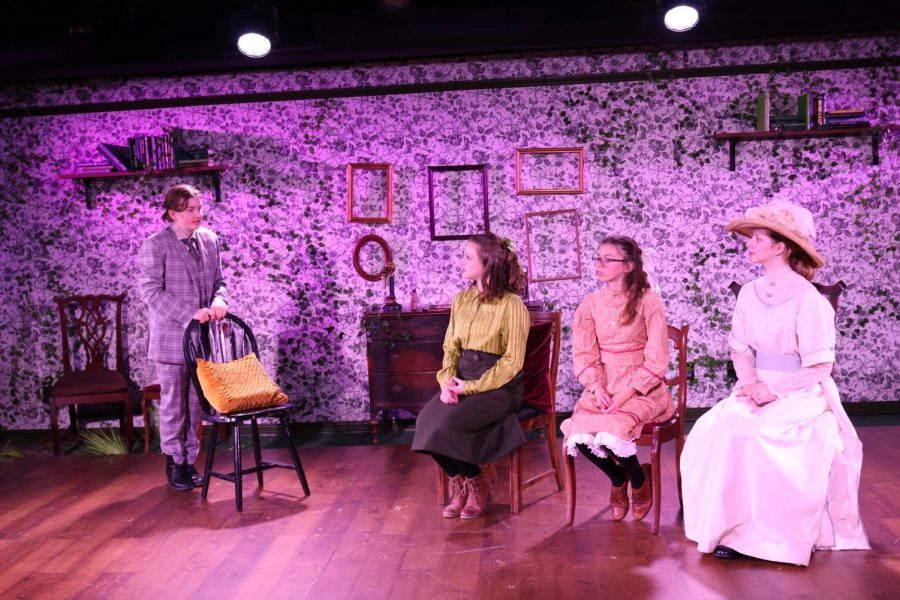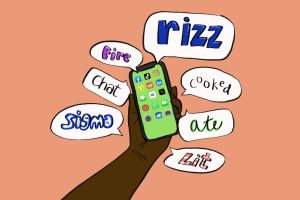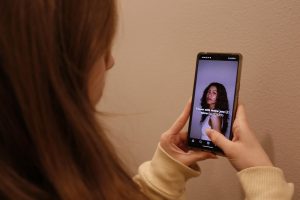‘The Light Burns Blue’: Middle school play brings story of hope to stage
Photo credit: Anna Entin
Sir Arthur Conan Doyle (Adella Travers ’27) talks to Elsie (Olivia Broock ’27), Francis (Charlotte Bloomfield ’28) and Elsie’s mother (Charlotte Burnap ’27) about the fairy photos they are creating and how they give him hope in the afterlife. The middle school production ran Jan. 13-14.
March 3, 2023
When a journalist publishes photos of fairies in England, people think they are real. This is the premise of “The Light Burns Blue,” this year’s middle school play, which was inspired by the true story of the Cottingley Fairies.
The play consisted of 24 cast members and 15 crew members, ranging from grades six through eight.
Eighth grader Olivia Broock has been a part of Archer’s theatre program since sixth grade. She originally auditioned for Winifred, the journalist sent to expose the fake fairy photographs. She was ultimately cast as Elsie Wright, the teenage girl who faked the fairy photographs.
“I really love that she had a lot of different sides to her because she wasn’t just angry all the time, although that was kind of a main part of her character,” Broock said. “She had all these deeper levels to her, and, in some scenes, she could just be a girl — and I was really happy for her because it felt like most of the show she was upset and hopeless.”
Penny Franklin is also in eighth grade and has been involved with middle school shows for a year and a half. She participated in the seventh grade musical last year and was excited to act as a leader this year.
“I think moments where I felt most connected to the message of the play is going through rehearsal and developing more as an actor and going into the role of Douglas,” Franklin said. “Once I really got into the place that I needed to be with that role and the character, that was when I connected most with my character and the other characters in the show.”
Franklin participates in theatre outside of school as well as Archer’s theatre programs. During the summer of 2022, she completed her first-ever theatre camp. She said she really enjoyed “The Light Burns Blue.”
“The two girls basically stuck cutouts of fairies into the floor and took photos and sent them out into a newspaper, and a lot of England believed it was real,” Franklin said. “It gave a lot of people hope.”
Throughout the play, middle school cast members connected with one another during show days and practices. The shows started at 3:15 p.m. There were five in total, including faculty shows, which took place on Jan. 13-14. Tracy Poverstein, the faculty director, said she picked the play because it talks about what defines an artist.
“To tell the story of these young women because it’s based on true people and a true story — I think that it made it more important to them that they tell the story,” Poverstein said. “We were having that experience of creating something in a play that is relatively new and that no one had seen before. Everyone got to originate these characters without having ever seen anyone do the parts before.”
Franklin said she is sad to graduate from middle school production but is excited to challenge herself through Archer’s upper school theatre program. She looks forward to participate in Poverstein’s Intro to Theatre class.
“I think doing more crew and tech in ninth grade is exciting,” Franklin said. “I would definitely do crew because it is an area of theatre I am excited to explore, although there are so many.”
Brooke said that her main takeaway is that no matter if she is with her friends in her grade or friends outside her grade level, the friendship she created through the theatre program will last forever. All cast members agreed that the play allows students from different grades to connect through shows.
“I feel like it does not completely go away when the show is over, I feel like it becomes really really strong,” Broock said. It is just different during a show and I think there is no way to really recreate that.”
The play raises questions about artistry, Poverstein said.
“What makes an artist?” she said. “Do we believe what we just want to believe?“









